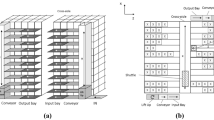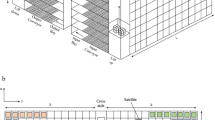Abstract
This paper studies multiple-deep automated vehicle storage and retrieval systems (AVS/RSs) known for their high throughput performance and flexibility. Compared to a single-deep system, multiple-deep AVS/RS has a better space area utilisation. However, a relocation cycle occurs, reducing the throughput performance whenever another stock keeping unit (SKU) blocks a retrieving SKU. The SKU retrieval sequence is undetermined, meaning that the arrangement is unknown, and all SKUs have an equal probability of retrieval. In addition to the shuttle carrier, a satellite vehicle is attached to the shuttle carrier and is used to access storage locations in multiple depths. A discrete event simulation of multiple-deep AVS/RS with a tier captive shuttle carrier was developed. We focused on the dual-command cycle time assessment of nine different storage and relocation assignment strategy combinations in the simulation model. The results of a simulation study for (i) random, (ii) depth-first and (iii) nearest neighbour storage and relocation assignment strategy combinations are examined and benchmarked for five different AVS/RS case study configurations with the same number of storage locations. The results display that the fivefold- and sixfold-deep AVS/RSs outperform systems with fewer depths by utilising depth-first storage and nearest neighbour relocation assignment strategies.





Similar content being viewed by others
Data availability
Not applicable.
Code availability
The simulation (MATLAB and Simulink) code of AVS/RS is available at https://github.com/m4r0lt/AVS-RS.
References
Boysen N, de Koster R, Weidinger F (2019) Warehousing in the e-commerce era: a survey. Eur J Oper Res 277(2):396–411
Park B.C. (2012) Order picking: issues, systems and models. In: Manzini R. (ed) Warehousing in the Global Supply Chain. Springer, London. https://doi.org/10.1007/978-1-4471-2274-6_1
Malmborg CJ (2002) Conceptualizing tools for autonomous vehicle storage and retrieval systems. Int J Prod Res 40(8):1807–1822
Lerher T, Sraml M, Potrc I, Tollazzi T (2010) Travel time models for double-deep automated storage and retrieval systems. Int J Prod Res 48(11):3151–3172
Malmborg CJ (2003) Interleaving dynamics in autonomous vehicle storage and retrieval systems. Int J Prod Res 41(5):1057–1069
Xu X, Shen G, Yu Y, Huang W (2015) Travel time analysis for the double-deep dual-shuttle AS/RS. Int J Prod Res 53(3):757–773
Lerher T (2016) Travel time model for double-deep shuttle-based storage and retrieval systems. Int J Prod Res 54(9):2519–2540
YetkinEkren B (2017) Graph-based solution for performance evaluation of shuttle-based storage and retrieval system. Int J Prod Res 55(21):6516–6526
Roodbergen KJ, Vis IFA (2009) A survey of literature on automated storage and retrieval systems. Eur J Oper Res 194(2):343–362
Marchet G, Melacini M, Perotti S, Tappia E (2012) Analytical model to estimate performances of autonomous vehicle storage and retrieval systems for product totes. Int J Prod Res 50(24):7134–7148
Carlo J, Vis IFA (2012) Sequencing dynamic storage systems with multiple lifts and shuttles. Int J Prod Econ 140:844–853
Roy D, Krishnamurthy A, Heragu SS, Malmborg CJ (2014) Blocking effects in warehouse systems with autonomous vehicles. IEEE Trans Autom Sci Eng 11(2):439–451
Ning Z, Lei L, Saipeng Z, Lodewijks G (2016) An efficient simulation model for rack design in multi-elevator shuttle-based storage and retrieval system. Simul Model Pract Theory 67:100–116
VDI-2692. 2015. Automated vehicle storage and retrieval systems for small unit loads.
Manzini R, Accorsi R, Baruffaldi G, Cennerazzo T, Gamberi M (2016) Travel time models for deep-lane unit-load autonomous vehicle storage and retrieval system (AVS/RS). Int J Prod Res 54(14):4286–4304
FEM 9.860. 2017. Guideline - Cycle time calculation for automated vehicle storage and retrieval systems. European Federation of Materials Handling.
D’Antonio G, De Maddis M, Bedolla JS, Chiabert P, Lombardi F (2018) Analytical models for the evaluation of deep-lane autonomous vehicle storage and retrieval system performance. Int J Adv Manuf Technol 94(5–8):1811–1824
D’Antonio G, Chiabert P (2019) Analytical models for cycle time and throughput evaluation of multi-shuttle deep-lane AVS/RS. Int J Adv Manuf Technol 104(5–8):1919–1936
Boywitz D, Boysen N (2018) Robust storage assignment in stack- and queue-based storage systems. Comput Oper Res 100:189–200
Ha Y, Chae J (2019) A decision model to determine the number of shuttles in a tier-to-tier SBS/RS. Int J Prod Res 57(4):963–984
Wang Y, Zhang R, Liu H, Zhang X, Liu Z (2019) Task scheduling model of double-deep multi-tier shuttle system. Processes 7(9):1–17
Eder M (2020) An approach for a performance calculation of shuttle-based storage and retrieval systems with multiple-deep storage. Int J Adv Manuf Technol 107(1–2):859–873
Wang Y, Man R, Zhao X, Liu H (2020) Modeling of parallel movement for deep-lane unit load autonomous shuttle and stacker crane warehousing systems. Processes 8(1)
Acknowledgements
This research work was supported by the Slovenian Research Agency (ARRS) in the framework of the (i) Applied research project entitled: “Warehousing 4.0 - Integration model of robotics and warehouse order picking systems”; grant number; L5-2626 and (ii) Bilateral research project between Slovenia and Norway entitled “Smart Intralogistics Systems: Integrating Vertical Lift Modules and Shuttle-based Storage and Retrieval Systems”; grant number: BI-NO/20-22-012.
Author information
Authors and Affiliations
Contributions
We are the first that directly compared the performance impact of nine (9) storage and relocation assignment strategy combinations in a multiple-deep AVS/RS. Our research includes a depth-first (storage and relocation) strategy that has not been used in any paper considering automated storage systems. The paper also shows that multiple-deep (fivefold- and sixfold-deep) AVS/RS can outperform AVS/RS with fewer depths by applying the ‘depth-first’ storage and ‘nearest neighbour’ relocation strategy.
Corresponding author
Ethics declarations
Consent for publication
All authors consent to the publication of this original paper.
Competing interests
The authors declare no competing interests.
Additional information
Publisher's note
Springer Nature remains neutral with regard to jurisdictional claims in published maps and institutional affiliations.
Appendix
Appendix
Rights and permissions
About this article
Cite this article
Marolt, J., Kosanić, N. & Lerher, T. Relocation and storage assignment strategy evaluation in a multiple-deep tier captive automated vehicle storage and retrieval system with undetermined retrieval sequence. Int J Adv Manuf Technol 118, 3403–3420 (2022). https://doi.org/10.1007/s00170-021-08169-x
Received:
Accepted:
Published:
Issue Date:
DOI: https://doi.org/10.1007/s00170-021-08169-x




